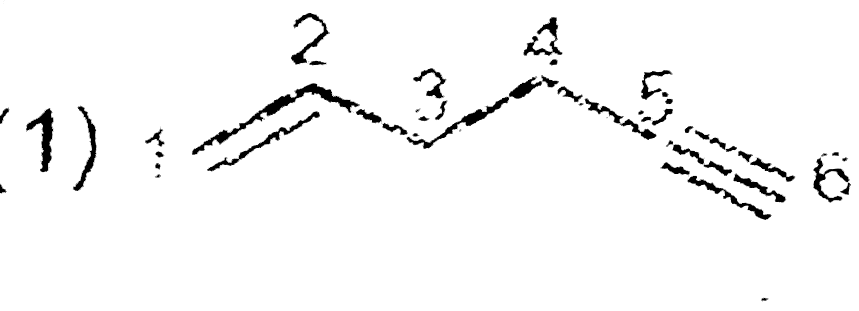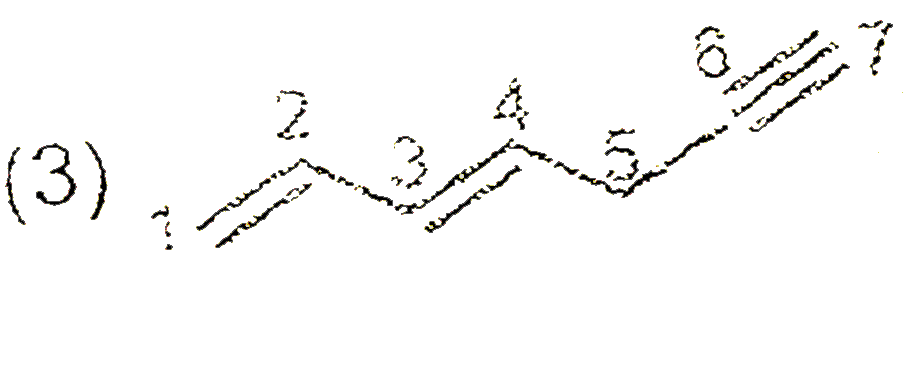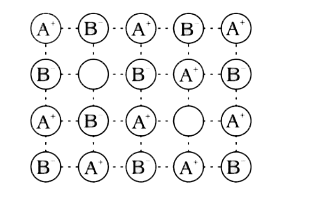Which of the following represent incorrect numbering.




The correct Answer is:B
To determine which of the given options represents incorrect numbering according to IUPAC nomenclature, we will analyze each structure step by step.
Step 1: Analyze the First Structure
1. Identify the Structure: The first structure has a triple bond and a double bond.
2. Numbering: Start numbering from the end closest to the double bond to give it the lowest locant.
- Numbering: 1 (double bond), 2, 3, 4, 5, 6 (triple bond).
- Locants: 1 and 6.
3. Conclusion: This numbering is correct as it gives the double bond the lowest number.
Step 2: Analyze the Second Structure
1. Identify the Structure: The second structure also has a double bond.
2. Numbering: Start numbering from the end closest to the double bond.
- Numbering: 1 (double bond), 2, 3, 4, 5, 6.
- Locants: 1 and 4.
3. Alternative Numbering: If we start from the other end:
- Numbering: 1, 2, 3, 4, 5, 6 (triple bond).
- Locants: 2 and 5.
4. Conclusion: The first set of locants (1, 4) is lower than (2, 5), so the correct numbering should start from the end with the double bond. The provided numbering in this option is incorrect.
Step 3: Analyze the Third Structure
1. Identify the Structure: The third structure has two double bonds.
2. Numbering: Start numbering from the end closest to the first double bond.
- Numbering: 1 (first double bond), 2, 3, 4, 5, 6, 7.
- Locants: 1, 4, 6.
3. Alternative Numbering: Start from the other end:
- Numbering: 1, 2, 3, 4, 5, 6, 7.
- Locants: 1, 3, 6.
4. Conclusion: The first set of locants (1, 4, 6) is lower than (1, 3, 6), so this numbering is correct.
Step 4: Analyze the Fourth Structure
1. Identify the Structure: The fourth structure has a similar arrangement.
2. Numbering: Start numbering from the end closest to the first double bond.
- Numbering: 1 (first double bond), 2, 3, 4, 5, 6, 7.
- Locants: 1, 4, 6.
3. Alternative Numbering: Start from the other end:
- Numbering: 1, 2, 3, 4, 5, 6, 7.
- Locants: 1, 2, 3, 4.
4. Conclusion: The first set of locants (1, 4, 6) is lower than (1, 2, 3, 4), so this numbering is also correct.
Final Answer
After analyzing all the options, the incorrect numbering is found in Option 2.
---
1. Identify the Structure: The first structure has a triple bond and a double bond.
2. Numbering: Start numbering from the end closest to the double bond to give it the lowest locant.
- Numbering: 1 (double bond), 2, 3, 4, 5, 6 (triple bond).
- Locants: 1 and 6.
3. Conclusion: This numbering is correct as it gives the double bond the lowest number.
1. Identify the Structure: The second structure also has a double bond.
2. Numbering: Start numbering from the end closest to the double bond.
- Numbering: 1 (double bond), 2, 3, 4, 5, 6.
- Locants: 1 and 4.
3. Alternative Numbering: If we start from the other end:
- Numbering: 1, 2, 3, 4, 5, 6 (triple bond).
- Locants: 2 and 5.
4. Conclusion: The first set of locants (1, 4) is lower than (2, 5), so the correct numbering should start from the end with the double bond. The provided numbering in this option is incorrect.
1. Identify the Structure: The third structure has two double bonds.
2. Numbering: Start numbering from the end closest to the first double bond.
- Numbering: 1 (first double bond), 2, 3, 4, 5, 6, 7.
- Locants: 1, 4, 6.
3. Alternative Numbering: Start from the other end:
- Numbering: 1, 2, 3, 4, 5, 6, 7.
- Locants: 1, 3, 6.
4. Conclusion: The first set of locants (1, 4, 6) is lower than (1, 3, 6), so this numbering is correct.
1. Identify the Structure: The fourth structure has a similar arrangement.
2. Numbering: Start numbering from the end closest to the first double bond.
- Numbering: 1 (first double bond), 2, 3, 4, 5, 6, 7.
- Locants: 1, 4, 6.
3. Alternative Numbering: Start from the other end:
- Numbering: 1, 2, 3, 4, 5, 6, 7.
- Locants: 1, 2, 3, 4.
4. Conclusion: The first set of locants (1, 4, 6) is lower than (1, 2, 3, 4), so this numbering is also correct.
After analyzing all the options, the incorrect numbering is found in Option 2.
Topper's Solved these Questions
- IUPAC NOMENCLATURE & STRUCTURAL ISOMERISM BOOK - RESONANCECHAPTER - IUPAC NOMENCLATURE & STRUCTURAL ISOMERISM EXERCISE - Advanced Level Problems Part-2 : Practice test-2
22 Videos
- IUPAC NOMENCLATURE & STRUCTURAL ISOMERISM BOOK - RESONANCECHAPTER - IUPAC NOMENCLATURE & STRUCTURAL ISOMERISM EXERCISE - Advanced Level Problems Part-3
18 Videos
- IUPAC NOMENCLATURE & STRUCTURAL ISOMERISM BOOK - RESONANCECHAPTER - IUPAC NOMENCLATURE & STRUCTURAL ISOMERISM EXERCISE - Exercise-3 Part-2
8 Videos
- IONIC EQUILIBRIUMBOOK - RESONANCECHAPTER - IONIC EQUILIBRIUMEXERCISE - partIII one or more than one options correct type
7 Videos
- METALLURGYBOOK - RESONANCECHAPTER - METALLURGYEXERCISE - INORGANIC CHEMISTRY(Metallurgy)
42 Videos
Similar Questions
Knowledge Check
Which of the following represents the correct number of chromosomes in various cell that are mentioned below?
A23 - 23 - 23 - 23B46 - 23 - 23 - 23C46 - 23 - 23 pairs - 23D23 pairs - 23 pairs - 23 - 23Which of the following represents incorrect representation of defect in crystals?
A B
B C
C D
D
Which of the following represents the incorrect order of ionic radii ?
AAl3+<Mg2+<Na+BNa+<Mg+<Al+CBr−>Cl−>F−Dnone of the above
Which of the following represents an incorrect match?
View SolutionWhich of the following reaction represent incorrect major product.
View SolutionWhich of the following represents the incorrect match of the alloy with its uses?
View SolutionWhich of the following reactions represent incorrect major product.
View SolutionWhich of the following options represent incorrect hybridization of its central atom for the respective species?
View Solution
